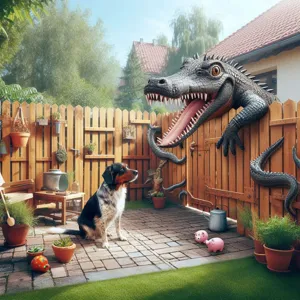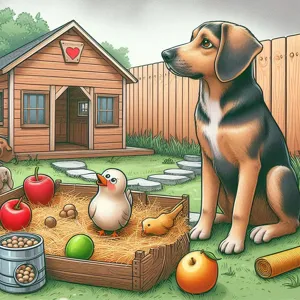Transforming your backyard into a dog-friendly haven is not only a rewarding task but also a crucial step in ensuring the safety and happiness of your furry companion.
With wagging tails and playful barks, our dogs thrive in environments where they can explore, play, and unwind. However, creating a space that is both enjoyable and secure requires careful planning and consideration. From selecting the right plants to establishing safe play zones, there are many aspects to consider in order to keep your pet safe while they bask in the sun or chase after their favorite toys. In this blog post, we’ll explore essential tips for designing a backyard that caters to your dog’s instincts, ensuring they have a safe and stimulating environment to enjoy. Join us as we dive into the essentials of creating a backyard paradise that your four-legged friend will love!
1. Understanding Your Dog’s Needs

Creating a dog-friendly backyard begins with a deep understanding of your furry friend’s needs. Each dog is unique, with different breeds, sizes, and temperaments that influence their behavior and preferences. Start by observing your dog’s habits—do they love to dig, chase after squirrels, or lounge in the sun? Recognizing these natural instincts will help you tailor your outdoor space to suit their lifestyle.
Consider your dog’s energy level as well. High-energy breeds like Border Collies or Jack Russell Terriers thrive in spaces that allow for ample running and play. Incorporate open areas where they can sprint freely or set up agility equipment to keep them mentally stimulated. On the other hand, calmer breeds may enjoy a cozy, shaded corner with soft grass for lounging and basking in the warmth.
Safety is also paramount in understanding your dog’s needs. Evaluate the potential hazards in your yard, such as toxic plants, sharp objects, or gaps in fencing that could allow for escape. Make sure your plants are non-toxic and remove any chemical fertilizers or pesticides that could harm your pet. Additionally, a secure fence will provide a sense of safety, allowing your dog to explore their space without the risk of wandering off.
Lastly, don’t forget about comfort! Providing a dedicated space for your dog—complete with a cozy dog bed, water bowl, and toys—will create an inviting atmosphere. By considering your dog’s physical, emotional, and safety needs, you can transform your backyard into a haven where they can thrive and find joy in every moment spent outdoors.
2. Assessing Your Backyard Space
Creating a dog-friendly haven begins with a thorough assessment of your backyard space. A safe, engaging environment is crucial for your furry friend, and understanding the layout and features of your outdoor area will help you identify what modifications or enhancements are needed to ensure their happiness and safety.
Start by examining the boundaries of your yard. Are there any gaps in the fencing that could allow a curious pup to escape? Look for any loose boards or areas where the ground may be uneven, as these can pose tripping hazards or potential hiding spots for mischievous escape artists. A secure, well-maintained fence is the first line of defense in keeping your dog safe while they enjoy their outdoor space.
Next, take stock of the landscape itself. Are there any toxic plants or flowers that could harm your pet if ingested? common culprits include azaleas, lilies, and certain types of ivy, so it’s wise to familiarize yourself with the plants in your yard and remove any that could pose a risk. Additionally, consider the ground cover—turf, mulch, or gravel can affect your dog’s comfort and play experience. Soft grass is generally the most inviting surface for running and rolling, while gravel can be tough on their paws.
Evaluate the availability of shade and shelter in your backyard. Dogs, especially those with thick coats, can easily overheat in direct sunlight. Ensure there are shaded areas where they can escape the sun’s rays, whether from trees, a patio, or a doghouse. If your yard lacks natural shade, consider erecting a canopy or constructing a simple shaded area where your dog can relax comfortably.
Finally, think about the overall layout of your backyard and how it can be optimized for play and exploration. Designate specific zones for different activities—like a space for fetch, a digging area, or a cozy corner for lounging. Adding dog-friendly features like agility equipment, a kiddie pool for splashing, or even a sandbox can provide mental stimulation and keep your dog engaged while they explore their outdoor haven.
By carefully assessing your backyard space and making thoughtful adjustments, you can create a safe and enjoyable environment for your dog to play, relax, and thrive. With the right setup, your backyard can become a beloved retreat for your furry friend, offering endless opportunities for fun and adventure.
3. Choosing Safe Plants and Landscaping

When transforming your backyard into a dog-friendly haven, one of the most crucial aspects to consider is your choice of plants and landscaping. While vibrant flowers and lush greenery can enhance the beauty of your outdoor space, it’s vital to ensure that the flora you select is safe for your furry companions.
Start by conducting thorough research on the plants you wish to introduce. Many common garden plants, such as lilies, azaleas, and sago palms, are toxic to dogs and can lead to serious health issues if ingested. Instead, opt for dog-friendly alternatives like sunflowers, marigolds, or snapdragons, which add color and vibrancy without posing a risk to your pet’s well-being.
In addition to plant selection, consider the landscaping features of your yard. If you’re planning to incorporate mulch, be cautious with cocoa mulch, which contains theobromine—an ingredient toxic to dogs. Instead, choose bark or cedar mulch, which are safe and provide a pleasant aroma.
When designing pathways or play areas, think about the materials you use. Avoid sharp stones or gravel that could injure your dog’s paws. Instead, consider softer options like grass, rubber mats, or sand, which provide comfort and cushioning for their playful antics.
Lastly, be mindful of any chemicals you might use in your garden. Fertilizers and pesticides can be harmful to dogs, so look for pet-safe alternatives. By creating a safe and inviting landscape with thoughtful plant choices and materials, you’ll ensure your backyard remains a peaceful retreat where your pup can roam freely and happily. With a little planning and care, you can cultivate a beautiful outdoor space that nurtures both your garden and your beloved pet.
4. Fencing Options for Secure Boundaries
When it comes to creating a dog-friendly haven, secure boundaries are paramount, and choosing the right fencing is a crucial step in ensuring your pup’s safety. A well-fenced yard not only provides your dog with the freedom to roam and play but also keeps them safe from potential dangers lurking outside your property.
There are several fencing options to consider, each with its own benefits and suitability depending on your dog’s size, temperament, and play style.
**1. Wooden Fences:** Classic and sturdy, wooden fences offer a natural look that complements any garden while providing reliable security. Opt for a height of at least six feet to deter jumpers, and ensure there are no gaps at the bottom where a curious pup might squeeze through.
**2. Chain-Link Fences:** These fences are durable, cost-effective, and allow for visibility, which can be comforting for both you and your dog. Consider adding a privacy slat to block out distractions that might entice your dog to bark or jump.
**3. Vinyl Fences:** If you’re looking for a low-maintenance option, vinyl fences are an excellent choice. They are weather-resistant and come in various styles, offering the same security as wood without the need for regular upkeep.
**4. Invisible Fencing:** For those who prefer a less obtrusive option, invisible fencing can create a boundary without a physical barrier. While it requires training to ensure your dog understands the limits, it can be a viable solution for larger areas.
**5. Pool Fencing:** If your backyard features a pool, installing a separate pool fence is essential. Look for a gate that automatically closes and latches, providing an extra layer of security to keep your furry friend safe from water hazards.
When choosing a fencing option, consider your dog’s behavior and needs. For example, if you have a high-energy breed, a taller fence may be necessary to prevent them from leaping over. Regularly inspect your fencing for any wear and tear, and ensure that gates are securely latched after each use. By investing in the right fence, you create a safe and inviting space for your dog to enjoy the great outdoors, giving you peace of mind and your furry friend a sense of freedom.
5. Designing a Comfortable Dog Area

Designing a comfortable dog area in your backyard is crucial for creating a space where your furry friend can relax, play, and feel secure. Start by choosing a location that is both shaded and sheltered, protecting your dog from harsh sunlight and inclement weather. Consider installing a cozy dog house or a stylish outdoor bed equipped with soft, washable bedding, giving your pup a personal retreat to escape to when they need a break from the action.
Next, think about incorporating elements that encourage play and exercise. A designated play zone with durable toys, like chew-resistant balls or tug ropes, can provide endless entertainment. If space allows, consider adding agility equipment, such as tunnels or jumps, to stimulate your dog’s mind and body. This not only helps keep them physically fit but also strengthens the bond between you and your pet as you engage in fun activities together.
Comfort is key, so ensure your dog area has a soft surface, such as artificial turf or rubber matting, to cushion their paws and joints while they romp around. Avoid using gravel or rough stones that can irritate their sensitive paws. Hydration is essential, too—install a shaded water station to keep your dog refreshed during playtime.
Finally, think about the overall aesthetics of your dog area. Use non-toxic plants and landscaping elements to create a visually appealing environment that complements your home. By designing a comfortable dog area that prioritizes safety and enjoyment, you’re not only enhancing your dog’s outdoor experience but also creating a welcoming haven where they can thrive.
6. Ensuring Shade and Water Access
Creating a dog-friendly haven in your backyard means prioritizing your furry friend’s comfort and well-being, especially when it comes to providing adequate shade and water access. As temperatures rise, dogs are particularly vulnerable to overheating, so it’s essential to offer shaded areas where they can retreat from the sun’s harsh rays. Consider planting trees or installing a sturdy gazebo that not only enhances your backyard’s aesthetics but also provides a cool refuge for your pooch.
Moreover, utilizing outdoor furniture, such as umbrellas or large shade sails, can create additional shaded spots where your dog can lounge comfortably. Keep in mind the layout of your yard; positioning these areas thoughtfully can ensure your pet has easy access to shelter while enjoying the fresh air.
Equally important is ensuring that your dog has constant access to fresh water. Install a durable, non-tip water bowl in a shaded area to prevent the water from heating up too quickly. For those particularly warm days, you might consider getting a pet water fountain, which not only keeps the water cool and flowing but also encourages your dog to drink more often, helping to prevent dehydration.
Regularly check and refill the water supply, especially during playtime or after long walks, to keep your dog hydrated and happy. By ensuring ample shade and water access, you create a safe and inviting atmosphere that allows your dog to enjoy your backyard all summer long.
7. Avoiding Common Hazards in Your Backyard

Creating a safe and inviting backyard for your furry friend requires vigilance and a keen eye for potential hazards that could pose risks to their health and well-being. Everyday elements that might seem innocuous to us can be dangerous for dogs, so it’s essential to assess your outdoor space thoroughly.
Start by examining your fence and gates. Ensure that they are tall enough and properly secured to prevent any daring escape attempts. Dogs are notorious for their curiosity and may try to squeeze through gaps or dig under fences if they sense something interesting on the other side. Regularly inspect these barriers for any wear and tear, and address any issues immediately.
Next, consider the types of plants and flowers you have in your backyard. While you may enjoy a beautiful garden, some plants can be toxic to dogs if ingested. Common culprits include azaleas, lilies, and sago palms. Make sure to research any new plants before adding them to your landscape and, if possible, opt for dog-safe varieties like sunflowers or marigolds.
Another often-overlooked hazard is standing water. Puddles, ponds, or birdbaths can be breeding grounds for mosquitoes and other pests, potentially exposing your dog to harmful diseases. Ensure that any water features are well-maintained and consider covering them or using natural deterrents to keep them clean and safe.
Additionally, take stock of your gardening supplies. Fertilizers, pesticides, and herbicides can contain harmful chemicals that are dangerous if ingested or absorbed through the skin. Store these products securely away from your pet’s reach and consider using organic alternatives that are less harmful to both your dog and the environment.
Finally, remember to keep your backyard tidy. Loose items, such as tools, cords, and small debris, can become tripping hazards or chew toys for an inquisitive pup. Regularly cleaning up and organizing your space not only makes it more enjoyable for both you and your dog but also significantly reduces the risk of accidents.
By taking these precautions and creating a safe environment, you can ensure that your backyard is a true haven for your dog—a place where they can explore, play, and relax without worry!
8. Creating Engaging Play Zones
Creating engaging play zones in your backyard is essential for keeping your dog happy, active, and mentally stimulated. Dogs are social creatures that thrive on interaction, and a thoughtfully designed play area can provide them with a safe haven to explore, play, and bond with you and other pets.
Start by designating specific zones for different activities. A spacious area with soft grass or artificial turf can serve as the main play zone where your dog can frolic freely. Consider using colorful agility equipment, such as tunnels, jumps, and weave poles, to encourage fitness and coordination. These structures not only promote physical activity but also offer your dog exciting challenges to overcome, stimulating their mind in the process.
Incorporating sensory elements can elevate the play experience. Think about adding a digging pit filled with sand or soil where your pup can indulge their natural digging instincts. You might also include a water feature, such as a small splash pool or a dog-friendly fountain, to keep your furry friend cool and entertained during warmer months.
Don’t underestimate the power of toys! Providing a variety of toys, from chew toys to fetch balls, will keep your dog engaged and prevent boredom. Rotating these toys every few weeks can reignite your dog’s interest and make playtime feel fresh and exciting.
Lastly, ensure that the environment is safe and secure. Check the area for any hazardous plants, sharp objects, or potential escape routes. Installing a sturdy fence will keep your dog contained while allowing them to explore their paradise. By creating engaging play zones in your backyard, you’ll not only enhance your dog’s quality of life but also strengthen the bond you share through play and adventure.
9. Incorporating Chew-Proof Furniture
Creating a dog-friendly haven in your backyard means considering every aspect of your outdoor space, including the furniture. Incorporating chew-proof furniture is a savvy way to safeguard your investment while also ensuring that your furry friend has the freedom to explore and enjoy their surroundings without causing damage.
When selecting furniture, opt for materials known for their durability and resistance to chewing. High-density polyethylene, stainless steel, and treated wood are excellent choices that can withstand the playful antics of even the most determined pups. Look for items specifically designed for pet owners, such as chew-proof cushions covered in tough, waterproof fabrics that resist tearing and staining.
Additionally, consider the height and design of your furniture. Low-slung benches and tables can provide a cozy spot for your dog to lounge without the risk of jumping or climbing onto delicate pieces. If you love the look of wicker or rattan, be cautious; while stylish, these materials can be particularly susceptible to enthusiastic chewing.
Incorporating chew-proof furniture not only protects your belongings but also adds to the overall aesthetic of your yard. Choose colors and styles that complement your garden, creating a cohesive look that you can enjoy just as much as your dog. With the right furniture in place, your backyard can be a true sanctuary for both you and your canine companion—one where you can relax together, knowing that everything is safe and sound.
10. Setting Up a Designated Bathroom Area
Setting up a designated bathroom area in your backyard is an essential step in creating a dog-friendly haven. Not only does this help keep your outdoor space tidy, but it also provides your furry friend with a consistent spot to relieve themselves. Choosing the right location for this area is crucial; look for a spot that is easily accessible and away from high-traffic zones where your dog often plays.
To create this space, consider laying down some gravel or mulch to define the area and make it comfortable for your dog. These materials are not only easy on their paws but also facilitate drainage, keeping the area cleaner and reducing odors. You can even plant some dog-friendly grasses or herbs around the perimeter, like rosemary or thyme, which can help mask any unwanted smells and provide a pleasant aroma in the air.
Additionally, establishing a routine by taking your dog to this designated area at the same times each day can help them understand that this is their bathroom spot. Praise and reward them each time they use it correctly to reinforce positive behavior.
Don’t forget to keep this area clean by regularly picking up after your pet and refreshing the substrate as needed to maintain hygiene. By creating a well-defined bathroom area, you’ll not only maintain a clean backyard but also contribute to your dog’s overall well-being, making your home a more enjoyable and inviting space for everyone.
11. Installing Safe and Fun Obstacles
Creating a dog-friendly haven in your backyard goes beyond just having a spacious area for your furry friend to roam. One of the most exciting ways to enhance their outdoor experience is by installing safe and fun obstacles. These additions not only provide physical exercise but also stimulate your dog’s mind, helping to keep them happy and engaged.
Start by considering your dog’s size, breed, and energy level when choosing obstacles. For smaller breeds, lightweight agility tunnels, low jumps, and weave poles can offer a fun challenge without overwhelming them. Larger dogs, on the other hand, might enjoy more robust equipment, such as sturdy climbing structures or A-frames that allow them to channel their energy in a productive way.
Safety should always be your top priority when designing an obstacle course. Make sure all materials are non-toxic and free from sharp edges. Opt for soft, durable materials that can withstand the rigors of enthusiastic play, such as rubber or treated wood. Additionally, ensure the ground is well-maintained, using grass or soft turf to cushion any falls.
Incorporating a variety of obstacles can also promote different types of play. Consider adding a splash pad or kiddie pool for hot days, a sandbox for digging, or even a balance beam to challenge their coordination. You can also create a scent trail using treats or toys to encourage them to explore and engage with their environment.
Finally, remember to change things up from time to time. Dogs, like people, can get bored with the same routine. By rotating obstacles or introducing new challenges, you keep their playtime fresh and exciting. With a little creativity and attention to safety, your backyard can become a beloved playground that your dog will enjoy for years to come.
12. Introducing Safe Toys for Outdoor Play
When it comes to creating a dog-friendly haven in your backyard, introducing safe toys for outdoor play is a crucial step that can elevate both your pet’s enjoyment and safety. Dogs are naturally curious and energetic, and providing them with engaging toys not only helps keep them entertained but also stimulates their minds and promotes healthy physical activity.
Opt for durable, non-toxic toys specifically designed for outdoor use. Look for materials that can withstand the elements, such as sturdy rubber or high-quality fabrics that resist fading from UV rays. Avoid toys with small parts that can easily break off or chewable elements that could pose choking hazards. Instead, consider sturdy options like frisbees, tug ropes, and balls designed for heavy chewing. These toys not only provide hours of fun but also help strengthen your dog’s jaw muscles and improve dental health.
Interactive toys, such as those that dispense treats or require problem-solving, can also enhance outdoor playtime. These toys challenge your dog mentally and can prevent boredom, which is essential for their overall well-being. Set up play areas with different toys to keep things fresh and exciting. Rotating toys regularly can also maintain your dog’s interest and engagement, making outdoor play a new adventure each time.
Don’t forget about the importance of supervision during outdoor play sessions. Always keep an eye on your dog while they’re playing with toys to ensure they’re safe and not chewing on anything they shouldn’t. Encourage playtime by joining in on the fun—play fetch, tug-of-war, or simply explore your yard together. This not only strengthens your bond but also allows you to monitor the condition of the toys and replace them if necessary.
By thoughtfully introducing safe toys for outdoor play, you create a vibrant and stimulating environment for your dog, making your backyard a true haven for joy and exploration. Your furry friend will thank you with wagging tails and playful antics, knowing they have a special space to enjoy their time outdoors.
13. Maintaining Your Dog-Friendly Space
Maintaining your dog-friendly space is crucial for ensuring it remains a safe, enjoyable haven for your furry friend. A well-kept yard not only enhances your dog’s playtime experience but also promotes their health and well-being. Begin by regularly inspecting the area for any potential hazards. This means checking for sharp objects, toxic plants, or any debris that could pose a risk to your pet. It’s a good idea to establish a routine inspection schedule—weekly or bi-weekly—to keep your backyard in top shape.
Next, focus on the grass and landscaping. Regular mowing is essential to prevent your dog from hiding ticks or fleas in the tall grass. If your yard has any shrubs or flowers, consider researching which plants are safe for dogs and removing any that could be toxic if ingested. Additionally, consider setting aside a designated area for your dog to dig or explore; this not only keeps them engaged but also minimizes damage to your landscaping.
Cleaning up after your dog is another vital aspect of maintenance. Not only is it important for hygiene, but it also prevents the spread of pests and diseases. Designate a specific area for waste and ensure you have the necessary cleaning supplies on hand. If possible, make it a habit to pick up waste immediately after your dog does their business.
Lastly, consider seasonal maintenance. In the spring, prepare your yard for the warm months by checking fences for any damage that might have occurred over the winter. In the fall, rake up leaves that can harbor mold or pests. During the winter, ensure your dog has a safe path to access the yard, free from ice or snow hazards.
By staying proactive about maintaining your dog-friendly space, you can create a safe, inviting environment that your dog will love to explore and enjoy for years to come.
14. Regularly Checking for Potential Risks
Creating a dog-friendly haven in your backyard requires vigilance and a proactive approach to safety. One of the most crucial steps in maintaining a safe environment for your furry friends is to regularly check for potential risks. This means making it a habit to walk through your yard at least once a week, inspecting it for any new hazards that could pose a threat to your dog’s well-being.
Start by examining the fencing around your yard. Look for any gaps or loose boards that could allow your dog to escape or stray into dangerous territory. Even small openings can be an invitation for curious pups, so ensure that your barriers are secure and intact.
Next, keep an eye out for toxic plants. While many plants may seem harmless, some can be highly toxic to dogs. Familiarize yourself with common garden plants that are dangerous, such as azaleas, lilies, and sago palms, and remove any that could pose a risk.
Don’t forget to check for harmful objects that may have found their way into your yard. This includes sharp tools, old garden stakes, or broken glass. These items can easily injure an unsuspecting dog that is exploring or playing in the yard. Consider performing a thorough clean-up of any debris or clutter that could lead to accidents.
Additionally, be mindful of chemicals, such as fertilizers, pesticides, or herbicides. Ensure that any products you use are pet-safe, and store them securely out of reach. Even residues left on the ground can be harmful, so water the area or cover it with grass or mulch once it has dried.
Lastly, assess the play areas. If you have a dog house or play equipment, check for wear and tear. Rusty nails, splintered wood, or sharp edges can turn a fun play session into a painful experience. Regular maintenance can help keep your dog’s playtime both enjoyable and safe.
By routinely checking for potential risks and addressing them promptly, you can create a serene and secure outdoor space where your dog can thrive. Remember, a little prevention goes a long way in ensuring that your backyard remains a happy haven for your four-legged family members.
15. Tips for Supervision and Socialization in the Backyard
Creating a dog-friendly haven in your backyard goes beyond just the physical space; it also involves ensuring your furry friends are well-supervised and properly socialized while they enjoy their outdoor playground. Supervision is paramount, especially if you have a curious pup who loves to explore. Always keep an eye on your dog, whether by staying in the yard with them or using a secure, enclosed space where they can roam freely without the risk of escaping. Consider setting up a comfortable seating area or a shaded spot where you can relax while keeping a watchful eye on your four-legged companion.
Socialization is equally crucial for your dog’s development and happiness. Introduce your pup to other dogs in a controlled environment, ensuring that they possess compatible temperaments and play styles. Organize playdates or invite friends over with their pets to create a friendly atmosphere where dogs can interact and learn appropriate behaviors. Use positive reinforcement to encourage good manners during these encounters, rewarding your dog for calm behavior and polite greetings.
Incorporating interactive elements into your backyard can also enhance socialization opportunities. Install a dog-friendly agility course or set up fun toys like tug ropes and fetch items to promote playtime and cooperative activities. If space permits, a dog-friendly sandbox can provide a stimulating environment for digging and exploring, which many dogs find enjoyable.
Remember to vary your activities to keep things fresh and exciting. Schedule regular backyard play sessions, allowing your dog to express their natural instincts while building confidence and social skills. By prioritizing supervision and creating opportunities for socialization, you’ll not only ensure your backyard is a safe haven but also a vibrant, engaging space where your dog can thrive.
In conclusion, transforming your backyard into a dog-friendly haven is not just about aesthetics; it’s about creating a safe and enriching environment for your furry friend to thrive. By implementing the essential tips we’ve discussed—from securing fences and removing toxic plants to providing engaging play areas and cozy resting spots—you can ensure that your dog enjoys the great outdoors while staying safe and happy. Remember, a well-designed space fosters not only physical activity but also strengthens the bond between you and your pet. So, roll up your sleeves and start making these changes today! Your pup will thank you with wagging tails and joyful barks, and you’ll create countless cherished memories together in your very own dog paradise.






